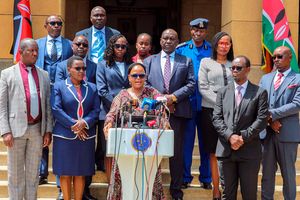Kenya’s bold vision for women: A review of progress 30 years after Beijing

Principle Secretary State Department of Gender and Affirmative Action Anne Wangómbe speaks at a past media breakfast.
What you need to know:
- Health outcomes for women and girls have seen positive development over the past five years.
- In education, the government has made strides to increase enrolment of girls in schools.
As Kenya reflects on the 1995 Beijing Platform for Action (BPfA) in light of its 30th anniversary, the recent Kenya Country Report offers valuable insights into the strides made towards gender equality and the empowerment of women and girls from 2020 to 2024.
Building on the findings from the 2019 Beijing + 25 report, this latest analysis showcases Kenya’s efforts towards addressing the 12 critical areas of concern highlighted in the BPfA, crucial for achieving the goals outlined in Sustainable Development Goal five on gender equality.
To facilitate understanding and progress tracking, the report clusters these areas into six overarching dimensions: inclusive development; poverty eradication; freedom from violence; participation and accountability; peaceful societies; and environmental conservation. Each dimension reveals how measures taken by the government reinforce both BPfA and the 2030 Agenda for Sustainable Development.
One of the notable areas of progress has been in employment legislation. The Employment Act of 2012 guarantees paid maternity leave and prohibits employment termination due to pregnancy. In addition, there is a commitment to ratifying International Labour Organisation conventions that enhance protections for women at work, showing a clear alignment between gender equality initiatives and economic growth.
Regarding economic empowerment, Kenya has adopted gender-responsive budgeting practices aimed at addressing gender disparities in public financial management. The national budget now increasingly reflects dedicated allocations to women's health, education, and economic empowerment, alongside affirmative action funds designed to uplift vulnerable populations. The Access to Government Procurement Opportunities programme has seen a rise in government tenders awarded to women from Sh15.5 million in 2018-19 to Sh24.8 million in 2022–23.
Health outcomes for women and girls have also seen positive development over the past five years. Notably, the percentage of live births assisted by skilled providers has increased from 41 per cent in 2003 to 89 per cent in 2022. Initiatives such as the Linda Mama programme have played a crucial role in providing free maternity services, which contribute to increased safe deliveries and a decline in maternal mortality rates.
In education, the government has made strides to increase enrolment of girls in schools. Overall, girls accounted for 51 per cent of enrolment in secondary schools in 2022–23. Further, the number of female candidates with C+ and above increased by 24.9 per cent to 96,247, while that of male candidates increased by 7.6 per cent to 104,895 in 2023. This is attributed to the full transition from primary to secondary education.
Despite these advancements, challenges remain, particularly regarding gender-based violence (GBV), which includes domestic violence, sexual violence, and harmful cultural practices such as female genital mutilation (FGM). In 2022, 15 per cent of girls and women aged 15–49 had undergone FGM compared to 21 per cent in 2014.
During the period under review, the government prioritised GBV through the establishment of specialised courts to handle related cases.
On appointive and elective leadership, gender diversity in the boardroom now stands at 36 per cent, which is significant progress from 21 per cent in 2017. In the Judiciary, women make up over 44 per cent of the workforce.
Following the 2022 General Election, there was a slight increase in women's representation to 23.3 per cent up from 21 per cent in 2017.
Regarding the environment, the government highlights the National Climate Change Action Plan (2018–22) as a tool that has helped it to integrate gender perspectives into policies and programmes for disaster risk reduction and building environmental and climate resilience. This involves appointing women to leadership roles within climate policy implementation.
The government also reports an increase in women’s participation in peace committees from 14 per cent in 2018 to 34 per cent in 2024. Principal Secretary for the State Department for Gender and Affirmative Action Anne Wang'ombe said while Kenya has made significant achievements, ongoing efforts are essential to address remaining gaps, particularly concerning violence against women and representation in leadership.
“As the country moves forward, a collaborative and committed approach will be vital to ensure every woman and girl can realise their full potential,” she said at a media roundtable in November 2024.





